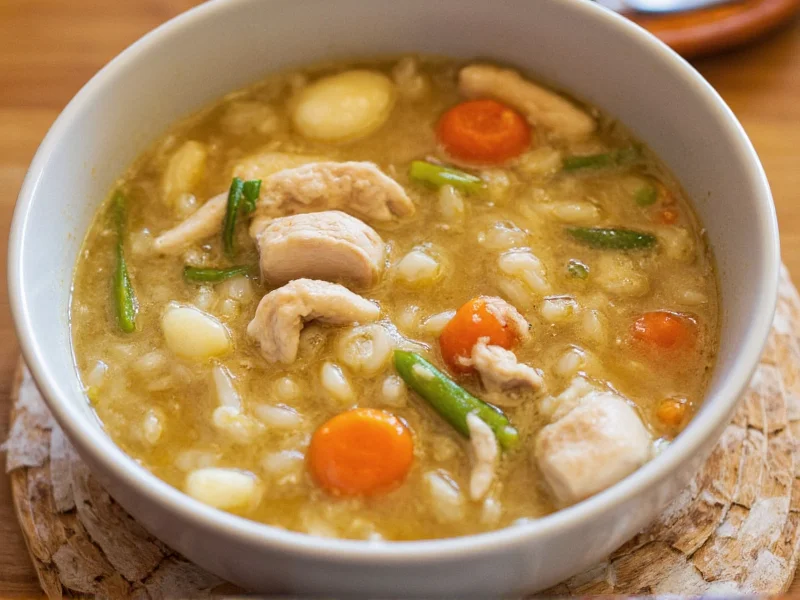Nothing beats a bowl of homemade chicken and rice soup when you need comfort food that's both nourishing and simple to prepare. Unlike canned versions, fresh preparation allows control over ingredients and flavor depth. The magic happens when chicken bones release collagen during simmering, creating a rich broth that's both soothing and packed with protein.
The Essential Chicken and Rice Soup Recipe
Creating exceptional chicken and rice soup starts with quality ingredients and proper technique. Many home cooks make the mistake of adding rice too early, resulting in overcooked, mushy grains. The solution? Cook the rice separately and add it just before serving.
Ingredients for Classic Chicken Rice Soup
- 1.5 lbs bone-in chicken thighs (skin-on for richer broth)
- 8 cups low-sodium chicken broth
- 1 cup long-grain white rice (cooked separately)
- 1 large onion, finely diced
- 2 carrots, sliced thin
- 2 celery stalks, chopped
- 3 garlic cloves, minced
- 1 bay leaf
- 1 tsp fresh thyme leaves
- Salt and freshly ground black pepper to taste
- 2 tbsp fresh parsley, chopped
Step-by-Step Preparation
- Build the broth foundation: Place chicken thighs in a large pot with chicken broth, onion, carrots, celery, and bay leaf. Bring to a gentle simmer (not boil) over medium heat.
- Simmer gently: Cook uncovered for 35-40 minutes until chicken reaches 165°F internally. Skim any foam that forms on the surface.
- Shred the chicken: Remove chicken, discard bones and skin, then shred meat into bite-sized pieces.
- Prepare rice separately: Cook 1 cup rice according to package directions. This prevents mushiness.
- Combine elements: Return shredded chicken to broth. Add cooked rice, garlic, thyme, salt, and pepper. Simmer 5 minutes.
- Finish: Stir in fresh parsley. Adjust seasoning before serving.
Avoiding Common Chicken Soup Mistakes
Most failed chicken and rice soup attempts stem from three critical errors. First, boiling instead of simmering creates cloudy broth and tough chicken. Second, adding rice directly to the soup pot guarantees overcooked grains. Third, skipping fresh herbs at the end results in flat flavor.
| Problem | Why It Happens | Solution |
|---|---|---|
| Mushy rice | Rice cooked too long in broth | Cook rice separately, add last 5 minutes |
| Cloudy broth | Boiling instead of simmering | Maintain gentle simmer, skim foam |
| Bland flavor | Insufficient seasoning layers | Season at each stage, finish with fresh herbs |
| Dry chicken | Overcooking boneless pieces | Use bone-in thighs, remove at 165°F |
Global Variations of Chicken and Rice Soup
Cultures worldwide have perfected their own versions of chicken and rice soup. Asian adaptations often feature ginger and rice noodles instead of grains. Latin American arroz caldo includes garlic oil and hard-boiled eggs. Southern Chinese versions incorporate preserved vegetables for umami depth.
For an easy chicken and rice soup recipe with Asian twist, add 1 tablespoon grated ginger and 2 sliced scallions during the last 5 minutes of cooking. Replace white rice with jasmine rice, and finish with a squeeze of lime. This healthy chicken and rice soup variation provides bright, clean flavors perfect for recovery days.
Perfect Storage and Reheating Techniques
Chicken and rice soup stores well when handled properly. Always cool soup completely before refrigerating. Store broth and rice separately if possible - this prevents the rice from absorbing all the liquid and becoming gummy. Properly stored, the broth base keeps for 4 days refrigerated or 3 months frozen.
When reheating homemade chicken rice soup for meal prep, add a splash of water or broth since rice continues absorbing liquid during storage. Gently warm over medium-low heat without boiling to preserve texture. Never microwave soup in plastic containers - transfer to glass or ceramic first.
Nutritional Benefits of Chicken Rice Soup
This classic combination delivers balanced nutrition. A standard serving (1.5 cups) contains approximately 250 calories, 20g protein, and essential vitamins from vegetables. The broth provides hydration and electrolytes, making it ideal when feeling under the weather. Using bone-in chicken increases collagen content, supporting joint and skin health.
For a low sodium chicken and rice soup recipe, use homemade broth or rinse canned broth under cold water to remove excess salt. Boost nutrition further by adding spinach or kale during the last 2 minutes of cooking. This transforms basic comfort food chicken rice soup into a complete meal.
Frequently Asked Questions
Can I use instant rice in chicken soup?
Instant rice works in chicken soup but requires careful timing. Add it during the last 2 minutes of cooking since it's pre-cooked. For best texture, regular long-grain rice cooked separately yields superior results in homemade chicken and rice soup recipes.
How do I prevent rice from getting mushy in soup?
Cook rice separately and add it just before serving. This technique for perfect chicken and rice soup ensures fluffy grains every time. If meal prepping, store rice and broth separately then combine when reheating.
What's the best chicken cut for rice soup?
Bone-in chicken thighs create the most flavorful broth for chicken and rice soup from scratch. Their higher fat content keeps the meat moist during simmering. For quicker preparation, boneless thighs work but require closer temperature monitoring to prevent drying.
Can I make chicken rice soup in a slow cooker?
Yes, but adjust the method for best results. Brown chicken first, then cook on low 4-6 hours. Remove chicken to shred, strain broth, and add separately cooked rice during the last 30 minutes. This slow cooker chicken and rice soup technique prevents mushy grains.
How long does chicken and rice soup last in the refrigerator?
Properly stored chicken and rice soup keeps for 3-4 days refrigerated. For longest freshness, store broth and rice separately. When reheating easy chicken and rice soup leftovers, add liquid as rice continues absorbing broth during storage.











 浙公网安备
33010002000092号
浙公网安备
33010002000092号 浙B2-20120091-4
浙B2-20120091-4